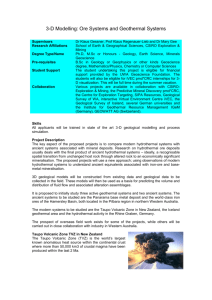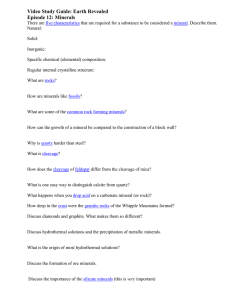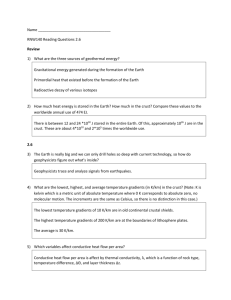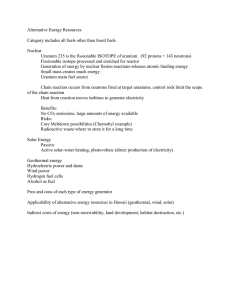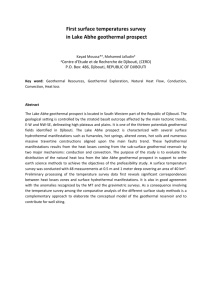Geothermics, Vol. 16, No. 2, pp. 181
advertisement
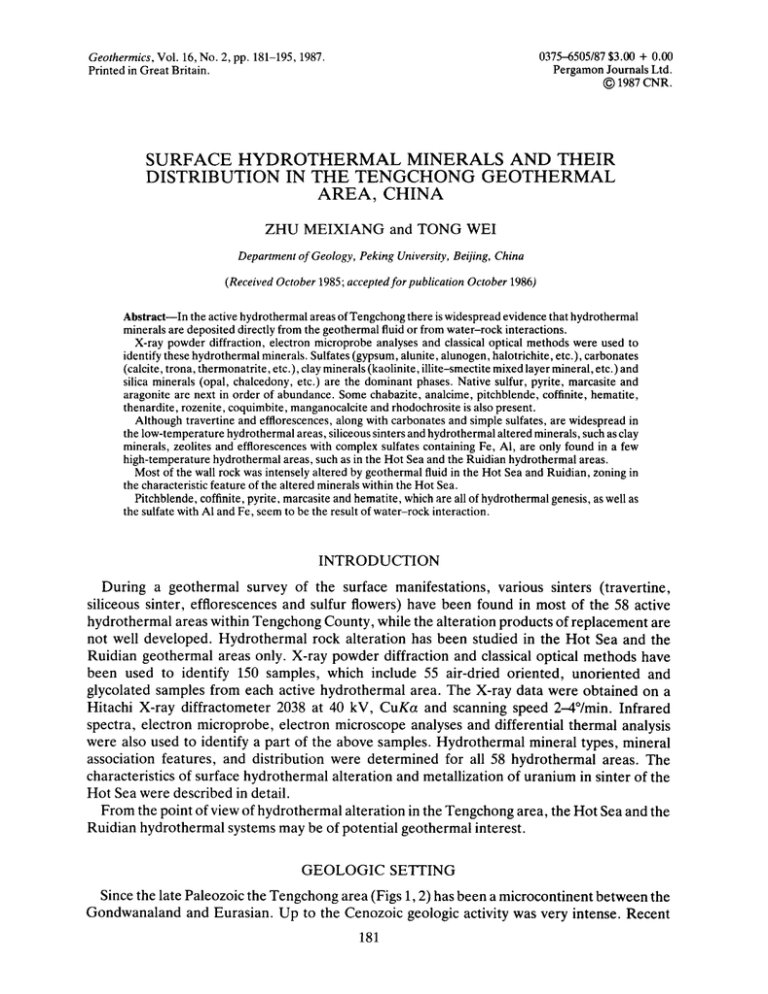
0375-6505/87 $3.00 + 0.00
Pergamon Journals Ltd.
~) 1987 CNR.
Geothermics, Vol. 16, No. 2, pp. 181-195, 1987.
Printed in Great Britain.
SURFACE H Y D R O T H E R M A L MINERALS AND THEIR
DISTRIBUTION IN THE TENGCHONG GEOTHERMAL
AREA, CHINA
Z H U M E I X I A N G and T O N G W E I
Department of Geology, Peking University, Beijing, China
(Received October 1985; acceptedfor publication October 1986)
Abstract--In the active hydrothermal areas of Tengchong there is widespread evidence that hydrothermal
minerals are deposited directly from the geothermal fluid or from water-rock interactions.
X-ray powder diffraction, electron microprobe analyses and classical optical methods were used to
identify these hydrothermal minerals. Sulfates (gypsum, alunite, alunogen, halotrichite, etc.), carbonates
(calcite, trona, thermonatrite, etc.), clay minerals (kaolinite, illite-smectite mixed layer mineral, etc.) and
silica minerals (opal, chalcedony, etc.) are the dominant phases. Native sulfur, pyrite, marcasite and
aragonite are next in order of abundance. Some chabazite, analcime, pitchblende, coffinite, hematite,
thenardite, rozenite, coquimbite, manganocalcite and rhodochrosite is also present.
Although travertine and efflorescences, along with carbonates and simple sulfates, are widespread in
the low-temperature hydrothermal areas, siliceous sinters and hydrothermal altered minerals, such as clay
minerals, zeolites and efflorescences with complex sulfates containing Fe, AI, are only found in a few
high-temperature hydrothermal areas, such as in the Hot Sea and the Ruidian hydrothermal areas.
Most of the wall rock was intensely altered by geothermal fluid in the Hot Sea and Ruidian, zoning in
the characteristic feature of the altered minerals within the Hot Sea.
Pitchblende, cofflnite, pyrite, marcasite and hematite, which are all of hydrothermal genesis, as well as
the sulfate with AI and Fe, seem to be the result of water-rock interaction.
INTRODUCTION
D u r i n g a g e o t h e r m a l survey of the surface manifestations, various sinters (travertine,
siliceous sinter, efflorescences and sulfur flowers) have been f o u n d in most of the 58 active
h y d r o t h e r m a l areas within T e n g c h o n g C o u n t y , while the alteration products of r e p l a c e m e n t are
not well developed. H y d r o t h e r m a l rock alteration has been studied in the H o t Sea and the
Ruidian g e o t h e r m a l areas only. X-ray p o w d e r diffraction and classical optical m e t h o d s have
been used to identify 150 samples, which include 55 air-dried oriented, u n o r i e n t e d and
glycolated samples f r o m each active h y d r o t h e r m a l area. T h e X-ray data were o b t a i n e d on a
Hitachi X-ray diffractometer 2038 at 40 kV, C u K a and scanning speed 2-4°/min. I n f r a r e d
spectra, electron m i c r o p r o b e , electron microscope analyses and differential thermal analysis
were also used to identify a part of the above samples. H y d r o t h e r m a l mineral types, mineral
association features, and distribution were d e t e r m i n e d for all 58 h y d r o t h e r m a l areas. T h e
characteristics of surface h y d r o t h e r m a l alteration and metallization of uranium in sinter of the
H o t Sea were described in detail.
F r o m the point of view of h y d r o t h e r m a l alteration in the T e n g c h o n g area, the H o t Sea and the
Ruidian h y d r o t h e r m a l systems m a y be of potential g e o t h e r m a l interest.
GEOLOGIC
SETTING
Since the late Paleozoic the T e n g c h o n g area (Figs 1, 2) has been a microcontinent b e t w e e n the
G o n d w a n a l a n d and Eurasian. U p to the C e n o z o i c geologic activity was very intense. R e c e n t
181
Zhu Meixiang and Tong We•
182
-,
~
.),.
~oo/~
t,
/~Coun<~
~.)
"%~IV'~.~'~ \~ll
~
~li
Te ngc hangt~ll~u~m_mg
Jifll
",
~
II
~../
•"
.~,w- ~
II . . . .
Bali Big Bot.h
.t.
Yingjiarig
_"
/
i
//Mengbeng
l /
/
~" ..,,*",
l
I" ;i.~
to
"~ ~
~"
(
.-
"-
~L
"~
/
~
f
(iDongji%zhai-¥ujiozhai
Sp, L
~--~JStone-wolt(
F.
N
" ~
I Yong-an
Bath Pool
~
I
/~
Cl
;
~
I
~
.anoo~Hot Pool
oox ~~ -°?
Of
~i
• .~
•
...7
~
.
,
/
)~..~<,ao (
~) Hot PooL. I
County
~"
"
."
•
/
• • \/
!
v
~,k~
"=\Ponzhihua
BoiLing Springs
/
\
.~Bo.~'.~..--'~"4\
,'--'J
~
_
~
Long-~n-gioo
/ . _,,"
, •
•
LionThe
J"
~Dozhuyuon Sp.
\
~" %. • •
/
e~) ~
.I C o u n ty = / /
)
(
_..,'
:
}2
e<
;
"~
~ BaosLien
r-
~. ?=
1 '~
.,J,.%o .~h~
k
•
•
•
~ Zongfu Sp.
.
Dacun HOt Pool ~ _ ~
.L
•
~.
- ~
O,
~CuonLong Bath
•
{,e,~,y• Tengchong
(~
~
Hat PooL ~
~ ~"
•
Oimucum
Blxth •
•Hueonapo
k~
(
•
gpo Worm
"
~
"~%
.#
{
/
1,/
Shanghoudian Hot , )
.._..~Lionghe
~
j~'~e'~f
/ f -
(.,,
~
I
o'zT~,'-o ,o
n O.
O a toO(lingSps eBeidong Bath
/•
//~/i
I
~
4
.
.
Ouingkou MoLishon Sps
l(~lili~
..'/~
Tengchong
-'7
///~
County "dlt
~
)-~ "%
rJ ~ Ill.
(
Datong Sps
Ruidion leaf ietd
Xiooshuibo Sp.
\',~,~
•~
/
,(:
County
t "
/ •
.
"•
Shobo Xiootong Sp i
7:°ox:o:,so
\"~
\'
•
,"
Xiootonggou Sp
I st•,?- ~ow~y
/ Covi't.ySps
I
I
IV
,o~,,oa
~
I/
;
J
•
I
I
"
/
.,
"~. •
•
LongLing
• County
"~.
•HubengSp. i/.e
• Bozhu Bath
)l
Fig. 1. Main geothermal manifestations in Tengchong, Western Yunnan.
",
•
Tengchong Geothermal Area, China
183
Fig. 2. Distribution of alteration zones in the Hot Sea geothermal field. A: alunite zone, K: kaolinite zone, I-S:
illite-smectite mixed layer mineral zone, FeS2: pyrite vein, F: fault, (1) boilingfountain, (2) boilingspring, (3) fumarole,
(4) hot spring, (5) siliceous sinter, (6) efflorescence, (7) native sulfur.
volcanoes and different fault structures are the most conspicuous geologic features. The recent
tectonics of Tengchong appear to be characterized by near NS linear features. The N E and N N W
fault systems form an "arched" structure.
There are 58 hydrothermal areas with different temperatures in Tengchong County. Their
distribution is controlled by the active faults in the above-mentioned arched structure. All the
high-temperature systems are related to recent volcanism. Most of the low-to-medium temperature hydrothermal areas, with mainly warm springs and hot springs, occur along these fault
zones on either side of the eastern and western parts of Tengchong, such as Stonewall Bath,
Xiabiaoyuan Xiaotang Spring and Qushi Xiaotangba Springs, etc., along the eastern zone and
the Black Mud Pool and Stone-flowery Cavity Springs, etc. along the western zone. Most of the
high t e m p e r a t u r e areas, with strong manifestations, are distributed along the m a j o r fault in the
central part of Tengchong County. Several high-temperature systems and their manifestations
were described in detail by Tong et al. (1986).
Based on chemical composition, the thermal waters in Tengchong area can be divided into two
main types: alkali chloride waters and bicarbonate sodium waters (Zhang et al., 1987).
HYDROTHERMAL
ALTERED MINERALS
The hydrothermal altered minerals identified within Tengchong area are:
184
Zhu Meixiang and Tong Wei
(',l) Sulfates
The varieties of sulfates recognized include gypsum, thenardite, alunogen, halotrichite,
rozenite, coquimbite and alunite (Table l). Alunite is the direct replacement of feldspar ill
primary rocks in the Hot Sea area. Others are usually euhedral, often in hairy and fibrous
aggregates. For example, alunogen often occurs in hairy form, and is rarely the crystal of a group
of parallel thin flaggy crystals (Fig. 3). Halotrichite occurs in the form of macroflaggy crystals
(Fig. 4). Thenardite is found only in Longpu Hot Pool, and is associated with rhodochrositc and
manganocalcite (Fig. 5).
(b) Carbonates
Calcite and trona are the dominant phases; calcite being the main component of travertine, it
is determined by main diffraction peaks of 3.04 ,~(100), 3.86 ,~(10), 2.29 A(20) and 2.10 A(18).
It is observed as late stage veinule aggregates in altered wall rock in Ruidian hydrothermal area.
A crustose aragonite (Table 2) is found as travertine within Xiabiaoyuan Xiaotang Spring.
Other carbonates, such as trona, thermonatrite (Table 2), rhodochrosite and manganocalcite,
are main components of efflorescences. Trona and thermonatrite are widespread in lowtemperature hydrothermal areas.
(c) Silica minerals
In decreasing order opal is the major phase, followed by chalcedony and hydrothermal quartz.
All are main components of siliceous sinter, and are the secondary minerals of altered wall rocks.
The opal X-ray diffractogram refers to the disordered form, with major broad X-ray peaks
from 4.06 to 4.12 ,~, similar to the fl-cristobalite described by Keith etal. (1978), and also to the
precious opal described by Jones et al. (1964). Infrared spectrogram shows that it is a typical opal
(Fig. 6).
Although the main X-ray peaks of quartz, 3.34 A(100), 4.26 A(35), 2.45 A(10) and
2.28 .~(10), are shown on the X-ray diffractogram of sinter from Spectacles Spring at Hot Sea,
chalcedony showing aphanitic aggregates is the dominant phase in thin section, whereas quartz
appears only as a few druses filling small cracks of chalcedony aggregates (Fig. 7).
(d) Clay minerals
Kaolinite and I-S mixed layer mineral, which have replaced feldspar and mica in the primary
rock, are the major clay minerals. Sometimes kaolinite has been replaced by halloysite and
allophane on the surface.
The clay minerals of the Hot Sea have been discussed in detail (Zhu, 1986). In the Ruidian
several samples determined by X-ray diffraction and electron microscope show that kaolinite is
the dominant phase, and, rarely the I-S mixed layer mineral. According to the standard
diffraction pattern of Thorez (1976), the X-ray powder diffractogram (Fig. 8) indicates the
presence of high order kaolinite in the Ruidian area.
The d(001) value invariably increased and the peak split by glycolation (Fig. 9), revealing the
presence of expandable layers in the illite. Increments of d(001) show that the minerals in this
area are illite-smectite random mixed layer minerals.
(e) Uranium minerals
Pitchblende and coffinite are found in chalcedony sinter from Spectacles Spring. The
pitchblende has a zonal (Fig. 10), crustose or spherulitic structure. Its chemical composition
determined by electron microprobe analysis is shown in Table 3. Coffinite is determined by
X-ray diffraction (Wei, 1980).
185
Tengchong GeothermaIArea, China
(f) Sulfides
Pyrite and marcasite usually occur in euhedral crystals (Figs 11, 12). Pyrite is rose-coloured
under the reflected light microscope. Both contain high cobalt (Co 0.726% in pyrite, Co 0.677%
in marcasite) by electron microprobe analysis.
In addition, trace amounts of chabazite and analcime also occur in altered rock of the Hot Sea
geothermal field. Native sulfur is well developed in high-temperature hydrothermal areas.
Table 1. X-ray powder diffraction data for several sulfate minerals
Alunogen
d(~l)
1
13.4
Halotrichite Rozenite
(2)
(3)
d(A)
I
d(A)
I
Alunite
~)
d(
I
60
10.4
9.5
7.81
6.73
100
30
20
3.96
3.89
3.62
3.59
20
20
20
10
3.46
3.36
15
20
3.10
3.02
15
15
10
20
5.96
5.23
4.76
4.62
30
10
100
10
4.27
4.09
3.93
3.74
50
30
30
40
3.47
3.36
9.40
8.52
8.26
40
20
90
6.36
5.49
10
80
4.74
4.60
20
40
10
10
4.49
4.37
4.31
(1)
(2)
(3)
(4)
(5)
Coquimbite
Gypsum
(4)
(5)
d(A)
I
d(A)
1
95
30
3.16
8
2.96
2.87
2.75
2.67
2.61
10
20
30
20
15
7.55
6.89
5.49
5.20
4.77
4.50
40
90
5
10
100
3.99
70
3.62
10
3.41
60
3.29
3.24
10
50
2.99
2.97
2.77
2.71
2.58
2.48
2.44
2.38
2.36
2.27
1.97
40
35
10
10
40
10
30
20
18
30
20
3.64
3.56
3.50
40
20
10
3.36
3.28
60
10
3.11
3.04
30
30
2.76
80
2.53
20
2.34
10
2.28
1.93
1.85
30
10
30
and (6) Sulfur-scooping Hole, Hot Sea.
Cucumber Gully, Hot Sea.
Pine Gully, Hot Sea.
Panzhihua Boiling Springs.
Gentlemen Bath, Ruidian.
100
4.27
40
3.78
50
3.06
30
2.86
10
2.68
2.59
10
1.897
1.81
16
10
5.75
10
4.99
30
3.52
70
3.36
15
2.99 100
2.89 10
2.48
5
2.21
1.92
1.90
1.74
1.50
10
10
30
20
30
Zhu Meixiang and Tong Wei
186
Fig. 3. Thin flaggy alunogen, Sulfur Pond. Scale: 501,m.
A
Fig. 4. Halotrichite in macroflaggy crystals, Cucumber Gully. Scale: 5 #m.
Ma RhTh
Th
,.
I
[
I
Rh
210
I
I
I
1251
Th
I
I
I
Th
I
310
,
I
I
MG
351
t
I
I
I
401
i
I
I
I
451
I
I
I
I
501
I
2e
Fig. 5. X-ray diffraction pattern of mixed sample of thenardite (Th), rhodochrosite (Rh) and manganocalcite (Ma
Longpu Hot Pool.
Tengchong Geothermal Area, China
36
28
20
18
16
14
12
IO
8
4
187
xlO 2 cm
/
Fig. 6. Infrared spectra of opal, Big Boiling Pan.
Fig. 7. Drusy quartz, Spectacles Spring.
188
Zhu Meixiang and Tong Wei
Table 2. X-ray powder diffraction data for several
carbonate minerals
Aragonite
Thermonatrite
Trona
(2)
o (11
d(A)
I
3.40
3.27
100
60
2.71
40
2.49
40
2.41
2.37
2.34
2O
35
40
2.19
2.11
10
20
1.98
80
1.88
1.82
1.75
35
25
20
t3)
d(/k)
I
9.82
50
4.91
4.00
40
20
3.21
3.08
2.77
6O
80
30
2.65
2.58
2.51
100
1()
30
2.48
2.45
2.42
5
45
10
2.26
2.18
2.14
2.06
2.04
1.997
1.96
1.88
d(A)
1
5.32
5.24
20
20
2.77 100
2.75
60
2.69
50
2.67
55
2.66
10
2.63
8
2.479 30
2.45
20
50
10
10
20
40
40
20
10
2.37
6(1
2.18
15
2.06
2.01
2.00
20
15
10
(1) Xiabiaoyuan Xiaotang Spring.
(2) Stone-wall Bath.
(3) Qushi Xiaotangba Springs.
O
0
(/3
i
i
I0
i
i
i
i
t
15
,
i
i
J
/
20
~
I
i
i
i
,
,
25
i
i
i
30
28
J
i
i
i
,
35
.
.
.
.
~
40
,
Tengchong Geothermal Area, China
189
Table 3. Chemical composition (%) of a zonal pitchblende
Light zone
Darkzone
U
Ca
Fe
Pb
80
68.2
0.3
0.5
0.9
0.6
0.8
0.9
Th
-
Si
-
-
--
-
--
ID
05
AI
tO
A g
~o
O3
u)
03
ed
0"I
tO.
i
/3'
I<
,¢
OLO
C'
I
_
~
m
r6
r6
~
N
Y
-'g
D'
~
~
0
N
v
l'to
D
m
~
tO
I'-:
v_
~
.,,e.
1.0
od
to
I',,- I D
!o
,
Lo
,2.,
i-,:,.
,.,.,.,.,.1:,.
,.,.,.,
4 6 8 I0 [~ 14 1611 2 0 2 2 ~ 1 2 6 L ~ 3 0
4 6 8 1012 141618 L~02224262830
28*
28 °
1.1.1.
i~
I~ItlLIAI
t I , I . I . L . ~
Fig. 9. X-ray diffractograms of clay minerals in the Hot Sea geothermal field. Samples A to D are air-dried, and A' to
D' are glycolated. I-S: illite-smectite mixed layer mineral, K: kaolinite, Q: quartz; sample AA' from Sulfur Pond; BB'
from Pine Gully, CC' from Dabaiyan, DD' from Bath Stream.
Fig. 8. (Opposite) X-ray diffraction of unoriented kaolinite. K: kaolinite, I-S: illite-smectite mixed layer mineral, O:
quartz. Ruidian geothermal field.
190
Zhu Meixiang and Tong Wei
Fig. 10. Zonal pitchblende, electron image (left), X-ray image of uranium (right), x30(t. Spectacles Spring.
Fig. I I. Euhedral crystals of pyrite, x 160. Pine Gully.
Fig. 12. Spear-like marcasite, ×65. Pine Gully.
Tengchong Geothermal Area, China
191
PARAGENESIS AND DISTRIBUTION OF HYDROTHERMAL MINERALS
The above-mentioned sulfates, carbonates and silica minerals are the dominant phases in
various sinters, while clay minerals and sulphides are found only in altered wall rock of
high-temperature hydrothermal areas.
The travertine mainly composed of calcite is distributed widely in Tengchong active hydrothermal area along the eastern and western fault zones. Large-scale travertine bodies exist in
some low-temperature areas, such as the travertine terrace in Black Mud Pool, the travertine
mushroom in Stone-wall Bath, the travertine hill in Stone-flowery Cavity Springs. The crustose
aragonites only occur on the surface of the travertine fan in Xiabiaoyuan Xiaotang Spring.
The efflorescences consisting of trona and thermonatrite occur in the low-temperature areas.
Trona efflorescences are widespread on travertine bodies in several hydrothermal areas, for
instance in Black Mud Pool and Stone-wall Bath. Thermonatrite is only found on laminated
travertine in Qushi Xiaotangba Springs and is associated with trona, and, rarely, halite.
The distribution of sihceous sinter, etflorescences of complex sulfate with AI, Fe and
carbonate with Mn, sulfur flowers, as well as hydrothermal minerals in altered wall rock are
concentrated in several high-temperature areas along the fault zone in the central part of
Tengchong. Siliceous sinters with small bodies seem to be restricted to the Hot Sea area.
Alunogens are well developed on steaming grounds, around fumaroles and boiling springs in
the Hot Sea and the Black Stone Stream Spring, where it is associated with native sulfur.
Efflorescences consisting of sulfate with AI, Fe have a restricted distribution; for example,
coquimbite is only developed in the fractures of biotite-gneiss and is closely associated with
native sulfur in Panzhihua Boiling Spring. The efflorescence consisted of carbonate with Mn,
which is only found near a boiling pond in Langpu Hot Pool. Hydrothermal minerals of wall
rock alteration have been studied in the Hot Sea and Ruidian. The primary rock in Ruidian is
quartz-monzonite, which has been altered by the geothermal fluid near the fault zone. The
primary feldspars are commonly replaced by kaolinites, and, rarely, by I-S minerals. Many
calcite aggregates as veinlets penetrated the veins of kaolinite. The zonation of the hydrotherreal minerals in Ruidian has not yet been studied in detail. The hydrothermal alteration of the
Hot Sea thermal field is described below.
HYDROTHERMAL ALTERATION OF THE HOT SEA GEOTHERMAL FIELD
The basement of the Hot Sea consists of Yanshanian granite. In late Tertiary age it may have
been a graben-like basin but it is now filled with Miocene granitic clastic sedimentary ro~k, which
acts as a shallow thermal reservoir within the basin. Coarse- to medium-grained sandstone is the
dominant lithologic type, and conglomerate is also relatively abundant. Breccia is sporadically
and irregularly distributed within the clastic rock. The breccia comprises angular detrital matter,
including rock fragments (abundant granite and scarce quartzite) and clastic minerals (abundant
quartz and scarce feldspar) and a siliceous or argillaceous matrix. The rock fragments are
characterized by angular and variable size (generally 20-30 cm - 1 - 2 cm in diameter). It remains
to be seen whether the rock fragments originated from a hydrothermal eruption.
There are a series of faults of north-south trend used as efficient channels for the ascent of
geothermal fluid within the Hot Sea. In addition, some pyrite and quartz veins with a near N-S
strike exist in the clastic sedimentary rocks (Fig. 2).
The intense surface manifestations occur in the Hot Sea, whose host rocks were extensively
affected by hydrothermal activity. High-temperature surface manifestations, such as hot pools,
boiling springs, fumaroles and steaming grounds, are concentrated along the Sulfur Pond-
192
Zhu Meixiang and Tong Wei
Cucumber Gully fault zone, while hot springs or warm springs, as well as a boiling spring near
Dadijiao fault, are distributed along fault zones on either side of the eastern and western parts
of the H o t Sea area.
D I S T R I B U T I O N A N D Z O N A T I O N OF H Y D R O T H E R M A L
ALTERED PRODUCTS
The distribution of various sinters are concentrated along the Sulfur P o n d - C u c u m b e r Gully
fault. In the eastern and western parts of this area there are no sinters except a few efflorescences.
Alunogens are widespread on the surface of the steaming grounds on the wall of a solfataric
fumarole and in the cavities or cracks of the host rock within the steaming ground, and are
associated with native sulfur, and, rarely, gypsum. Halotrichite and rozenite were found on the
surface of all pyrite veins.
All three siliceous sinters found in Tengchong are located in the H o t Sea area. There is a fossil
sinter terrace of 1.5 m height nearby Past Boiling Pan. It is a white laminated opal sinter,
containing abundant casts of plant stems, roots and leaves. Recently an opal sinter rim was still
precipitating around the margins of Big Boiling Pan. A chalcedony sinter with developed
lamination can be observed around Spectacles Spring. It has the form of a shallow d o m e 3 m in
diameter at the bottom. It contains disseminated pitchblende, coffinite, pyrite, marcasite and
hematite. The ribboned texture of the sinter resulted from the orientation of these mineral
aggregates along its lamination (Fig. 13).
Fig. 13. Ribboned sinter, x 1.5; Spectacles Spring.
The Tertiary clastic rocks were altered by the geothermal fluid. The alteration of the wall rock
and paragenesis of the hydrothermal minerals are closely related to the fissures, the permeability
of the primary rocks, and the temperature and nature of the geothermal fluid. Two altered
centres have developed (Fig. 2). In Sulfur P o n d - C u c u m b e r Gully fault, this centre develops
outwards as alunite-kaolinite z o n e - k a o l i n i t e - I - S zone. In Dadijiao fault the inner zone is I-S
and its outer zone is I-S kaolinite. In both zones the intensity of alteration is closely related to
fissures. The nearer the zone is to the centre, the stronger is alteration. All altered rocks
consisting of pure kaolinite, pure alunite and pure I-S appeared as lenticular bodies distributed
Tengchong Geothermal Area, China
193
in or near the faults. This distribution is similar to that of the Otake field (Hayashi, 1973). The
zonal patterns of two centres also exist in the Los Azufres field in Mexico. Cathelineau et al.
(1985) showed that two zones resulted from a main aquifer at depth, which discharged through
two circulation zones, which probably originate from two main fracture systems. Because of
limited drillings in the Hot Sea the situation at depth has not been studied.
Pyrite veins in primary rock were also affected by hydrothermal activity. Primary coarse pyrite
was repeatedly replaced by hydrothermal pyrite and marcasite (five or six times) (Zhu et al.,
1985). The temperature of primary pyrite and hydrothermal pyrite is 300°C and 180°C
respectively (Jiang Li-min, oral comm.), which suggests that the former is of magmatic origin
and the latter of geothermal origin.
ZONAL CAUSES OF HYDROTHERMAL ALTERATION
The chemical composition of the geothermal fluid is evidently an important factor controlling
altered zonation. Judging from the mineral associations the first centre has an acid environment,
and the second has a neutral-weak alkaline one.
During ascent of deep geothermal fluid part of the HzS and CO2 rich solution ascends to or
near the surface along the Sulfur Pond-Cucumber Gully fault. The solution becomes acid due
to oxidation of hydrogen sulfide. On the one hand, the association of kaolinite with alunite
and/or SiO 2 minerals have occurred as a result of interaction between the reservoir rock and the
acidic fluid. Zoning from the centre outwards is consistent with acid solutions moving outwards
from channels and becoming more alkaline by reaction with the reservoir rocks (Browne, 1978).
At the same time, the original pyrite vein in the clastic rock is replaced by hydrothermal pyrite
and marcasite under the action of the hydrothermal fluid. The close spatial relationship between
Fe-bearing sulfate and pyrite-marcasite veins indicate that pyrite is the source of iron.
Another part of the deep fluid might rise directly to or near the surface along the Dadijiao
fault. The fluid represented basically the property of a deep fluid (Zhang Zhifei, oral comm.)
which reacts with the wall rock and results in I-S mixed layer minerals.
URANIUM MINERALS IN SILICEOUS SINTER
The basement rocks in and near the Hot Sea area have a relatively high radioactive
background; the granite is 67 y-ray equivalents and the clastic rocks 61 ~' (Dai etal., 1984). There
are some small post-leaching uranium deposits in the clastic rock in an area near the Hot Sea.*
Radioactive anomalies in these deposits prior to geothermal activity reached 1000-2000 V, and
the highest 3000 y. Uranium mineralization extends to a depth of 0-400 m.
Geothermal activity facilitates uranium leaching, transportation and concentration from
reservoir rocks. Barbier (1974) indicated that much of the uranium in granitic rocks is leachable
even during surface weathering. Thus, strong geothermal activity and the good permeability of
the clastic rocks provide more favourable conditions for uranium leaching. Robert (1982)
studied the mobility of uranium during alteration of rhyolite ash to montmorillonite and showed
that the mobility of uranium is related to dissolubility of SIO2. It is inferred that intense
alteration and the high-temperature fluid rich in SiO2 favoured leaching and transportation of
uranium.
The alkaline environment facilitated the formation of siliceous sinter (Walter, 1978), and in
the alkaline solution UO2(CO3)~- and UO2(CO3)4- are probably the major species of uranium;
*GeologicalBrigade209, GeologicBureau, Ministryof NuclearIndustry,1979,Internalreport.
194
Z h u Meixiang and Tong Wei
CO2 may be important for uranium transport (Rich et al., 1977). Since the geothermal fluid in
the area is rich in C O 2, uranium could be transported as a uranic complex with carbonic acid.
Because of convective heat loss, direct concentration and cooling, the highly supersaturated
silica precipitated from the fluid rising to the surface. CO2 loss from ore solution during boiling
played a major role in the precipitation of pitchblende (Rich et al., 1977). Part of the uranium
formed pitchblende, and another part combined with SiO2 formed coffinite. Since the geothermal fluid is rich in SiO2, coffinite content should be higher, but this has not been observed. Bei
Yuming (oral comm.) showed that coffinite is a p s e u d o m o r p h of pitchblende under the reflecting
microscope. Hostether et al. (1962) showed that coffinite rapidly altered under oxidizing
conditions. Judging from the development of the drusy quartz, after the sinter formed it may
have developed from opal to chalcedony. This transformation was also observed in Steamboat
Spring (White, 1964). Thus, the chalcedony sinter in Spectacles Spring is considered to be an
older sinter. During transformation the coffinite was altered by oxidation or replaced by
pitchblende.
CONCLUSIONS
H y d r o t h e r m a l mineral associations are controlled by intensity of geothermal activity in
Tengchong area. Large-scale travertine bodies can be seen in the low-temperature areas,
whereas siliceous sinters only occur in the high-temperature areas. Efflorescences made up of
trona and thermonatrite in the low-temperature areas are the direct precipitations of ascending
fluid, while efflorescences of sulfate with AI, Fe and carbonates with Mn in the high-temperature
areas are the products of w a t e r - r o c k interaction.
Alunogen and halotrichite are often found in the hot springs in some active volcanic areas,
such as Mount St Helens (Keith et al., 1983) and Latera caldera (De Rita et al., 1983). In
Tengchong area they occur in the high-temperature areas with steam grounds and fumaroles and
are closely associated with native sulfur. This seems to suggest that geothermal activity is closely
related to young volcanic activity.
Although there have been many discussions about the relationship between metallization and
active hydrothermal systems (White, 1955; Weissberg, 1979; Sims et al., 1981; Ellis, 1969:
Dickson et al., 1971; Browne, 1971) uranium mineralization in recent hydrothermal systems has
never been reported in the literature as far as we know. This paper suggests that the precipitation
of pitchblende and coffinite in sinter are related to hydrothermal activity in the Hot Sea. The
uranium disseminated in the clastic rocks was enriched and carried up to or near the surface by
geothermal fluids rich in SiO2, and then deposited together with silica, as a result of water-rock
interaction. The replacement of original pyrite by post-depositional pyrite and marcasite is also
the result of water-rock interaction.
This research on hydrothermal alteration in the Tengchong area indicates that a few intensive
active hydrothermal areas, such as the Hot Sea and the Ruidian geothermal area, may be
potential exploration regions.
Acknowledgements--We would like to thank Peng Zhizhong (Beijing Graduate School, Wuhan College of Geology),
Ren Leifu, Cao Zhengmin and Jiang Shaoying (Geological Company of State Bureau of Building Materials Industry)
for their advice and help in identificationof minerals. We are also grateful to Liao Zhijie, Liu Shibin and Zhou Changjin
(Commission on Multidisciplinary Exploration of Natural Resources, Academia Sinica, Beijing, China) for collecting
part of the samples. We are also greatly indebted to Sheng Minzi for useful advice on the manuscript.
REFERENCES
Barbier, J. (1974) Continental weathering as a possible origin of vein-type uranium deposits. Mitt. Dep. 9,271-288.
Browne, P. R. L. (1971) Mineralization in the Broadlands Geothermal Field, Taupo Volcanic Zone. Soc. Min. Geol.
Jap. Spec. 2, 64-75.
T e n g c h o n g G e o t h e r m a l Area, China
195
Browne, P. R. L. (1978) Hydrothermal alteration in active geothermal fields. Ann. Rev. Earth Planet. Sci. 6,229-250.
Cathelineau, M., Oliver, R., Nieva, D. and Garfias, A. (1985) Mineralogy and distribution of hydrothermal mineral
zones in Los Azufres (Mexico) Geothermal Field. Geothermics 14, 49-57.
Dai Jiemin and Liang Xingzhong (1984) A preliminary discussion of uranium mineralization related to ground hot
waters. Geochim. 3,269-272 (in Chinese).
De Rita, D., Funiciello, R., Nappi, G., Rossi, U. and Villa, I. M. (1983) Evolution of the Latera geothermal system I:
geology, stratigraphy and geochronology of the Latera caldera. Proc. IV Int. Syrup. Water-Rock Interaction, Misasa,
Japan, pp. 116-118.
Dickson, F. W. and Tunell, G. (1970) Mercury and antimony deposits associated with active hot springs in the Western
United States. In Ore Deposits of the United States, 1933-1967 (Edited by Ridge, I. D.) Vol. 11, pp. 1694-1700. Am.
Inst. Mining Metall. Petrol. Engrs, New York.
Ellis, A. J. (1964) Present-day hydrothermal systems and mineral deposition. Proc. Ninth Commonwealth Mining and
Met. Congress. (Mining and Petroleum Section) London, Inst. Mining and Metallurgy, pp. 1-30.
Ellis, A. J. and Mahon, W. A. J. (1977) Chemistry and Geothermal Systems. Academic Press, New York.
Hayashi, M. (1973) Hydrothermal alteration in the Otake geothermal area, Kyashu. Jap. Geoth. En. Ass. Bull. 10, 9-46.
Hostether, P. B. and Garrels, R. W. (1962) Transportation and precipitation of uranium and vanadium at low
temperature, with special reference to sandstone-type uranium deposits. Econ. Geol. 57, 137-167.
Jones, J. B., Sanders, J. V. and Segnit, E. R. (1964) Structure of opal. Nature 204,990-991.
Keith, T. E. C., White, D. E. and Beeson, M. H. (1978) Hydrothermal alteration and self-sealing in Y-7 and Y-8 drill
holes in northern part of Upper Geyser Basin, Yellowstone National Park, Wyoming. Geol. Surv. Prof. Paper
1054-A.
Keith, T. E. C. (1983) Mineralogical and chemical changes in fumarolic deposits with time at surface conditions. Proc.
IV Int. Syrup. Water-Rock Interactions, Misasa, Japan, pp. 231-234.
Rich, R. A., Holland, H. D. and Petersen, U. (1977) Hydrothermal Uranium Deposits. Elsevier, New York.
Robert, A. Z. (1982) The mobility of uranium and other elements during alteration of rhyolite ash to montmorillonite:
a case study in the Troublesome Formation, Colorado, U.S.A. Chem. Geol. 35,185-204.
Sigvaldason, G. E. (1977) Geochemical methods in geothermal exploration. In Geothermal Energy (Edited by
Armstead, H. C. H.) pp. 49-59. UNESCO.
Sims, J. D. and White, D. E. (1981) Mercury in the sediments of Clear Lake Geothermal Area, Northern California
(Edited by McLaughlin, R. J. and Donnelly-Nolan, J. M.). Geol. Surv. Professional Paper, 141, pp. 237-241.
Thorez, J. (1976) PracticalIdentification of Clay Minerals (Edited by Lelotte, G). B4820. Dison, Belgium.
Tong Wei, You Maozheng, Lift Shibifi and Zhang Mingtao (1986) Hydrothermal systems in Tengchong, West Yu'nnan,
China and their evolution during the past 400 years. Geothermics 15,331-337.
Walter, M. R. (1978) Geyserites of Yellowstone National Park: an example of abiogenic "stromatolites". In
Developments in Sedimentology, 20. Stromatolite (Edited by Walter, M. R.) pp. 87-112. Elsevier, Amsterdam.
Wei Sihua (1979) Uranium Mineral of China. Atomic Energy Press, Beijing.
Weissberg, B. G., Browne, P. R. L. and Seward, T. M. (1979) Ore metals in active geothermal systems. In Geochemistry
of Hydrothermal Ore Deposits, 2nd Edn (Edited by Barnes, H. L.) pp. 738-782. John Wiley, NY.
White, D. E. (1955) Thermal springs and epithermal ore deposits. Econ. Geol. 50th Ann., pp. 99-154.
White, D. E., Thompson, G. A. and Sandberg, C. H. (1964) Rocks, structure, and geologic history of Steamboat
Springs Thermal Area, Washoe County, Nevada. Geol. Surv. Prof. Paper 458-B.
Zhang Zhifei, Liu Shibin and Zhao Fengsan (1987) Geochemistry of thermal waters in the Tengchong volcanic
geothermal area of west Yunnan Province, China. Geothermics, 16, 169-179.
Zhu Meixiang (1986) Hydrothermal clay minerals in Hot Sea (Rehai) Thermal Field, Tengchong, Yunnan Province. Sci
Sin. (Series B) 29,430-440, Beijing.
Zhu Meixiang and Wei Qiying (1985) Active mineralizations in the high temperature geothermal fields in XizangYunnan Areas. In The records of Geological Research, pp. 191-199. Peking University Press, Beijing (in Chinese).
